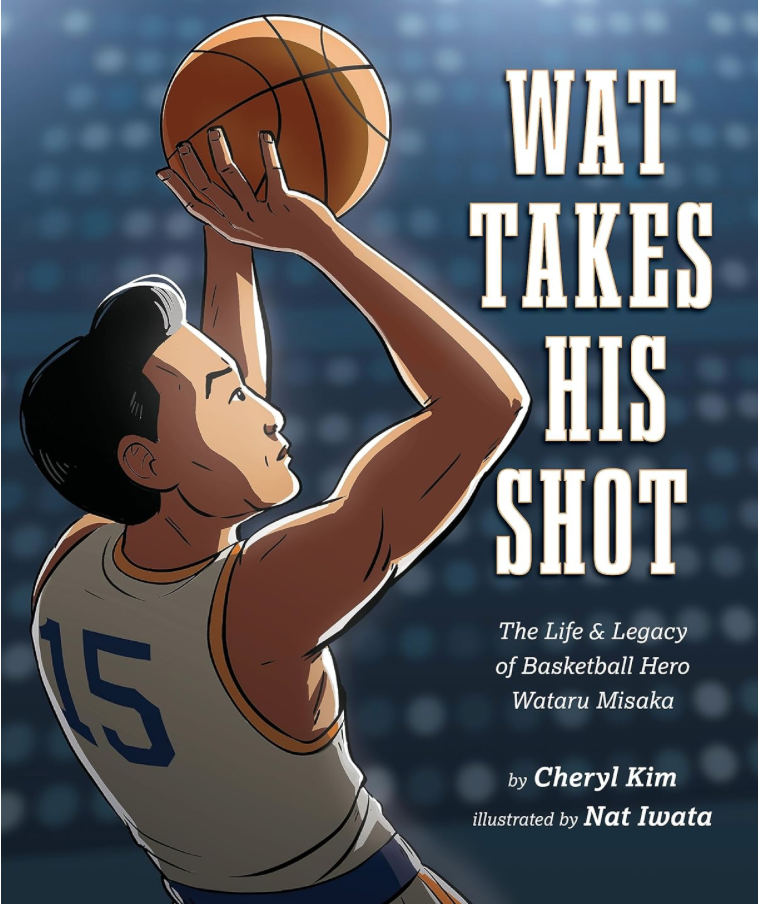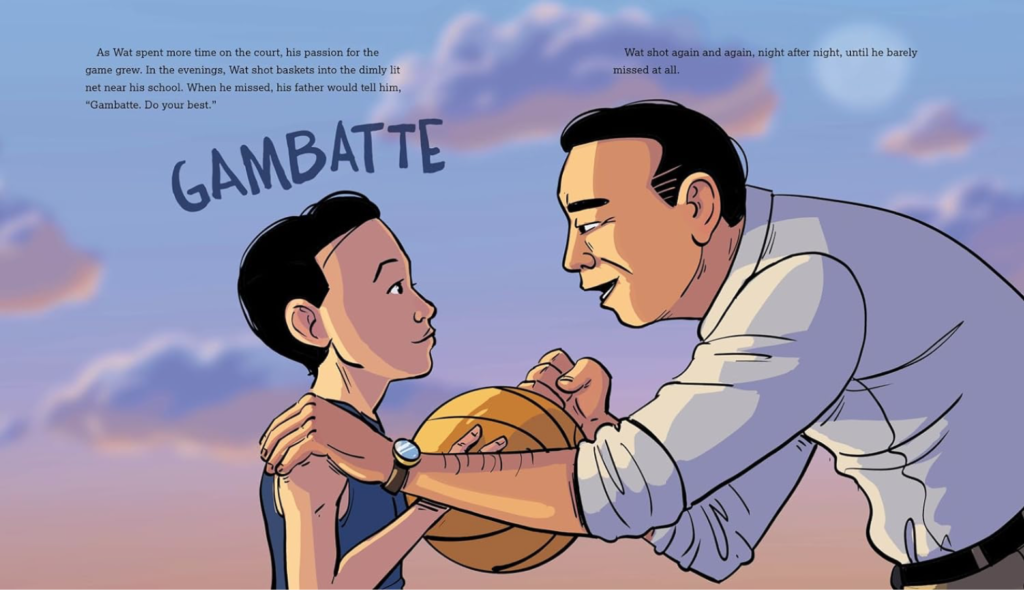While I love biographies, and teachers sometimes check them out for lessons, this part of the library collection has not been particularly popular with my students. They do, however, love sports books, whether of the fun facts variety, odes to favorite local teams, or photo-heavy manuals. A few weeks ago, it hit me. Maybe one way to boost interest in the biography section is to add more sports heroes. Basketball is our only school team, so Wat Takes His Shot: The Life and Legacy of Basketball Hero Wataru Misaka by Cheryl Kim and Nat Iwata seems like the perfect title to test this theory. As a child, Wat loved playing basketball in his hometown of Ogden, Utah. Facing adversity at a young age, including losing his father and rising racism against Japanese Americans during World War II, Wat became a star on his college team and eventually joined the Knicks, where he became the first person of color to play with the NBA. This biography has plenty of action-packed game scenes, WWII history (another popular topic among my upper elementary students), and messages of perseverance and hope. This book comes out next week and I am excited to have a copy on order for my library for next school year. We are lucky to have Cheryl here today to answer a few questions about writing this book…and share a generous giveaway with us!

Cheryl, What drew you to Wataru Misaka as a biography subject? What do you hope children will take away from learning about his life?
Around the time I was writing another picture book biography, I watched the Linsanity documentary with my sons. At first, I assumed Jeremy Lin was the first Asian American NBA player since he was the only one I had heard of. I was shocked to discover there were others before him, and that the first was a man named Wataru Misaka who broke the color barrier in basketball the same year Jackie Robinson broke the color barrier in baseball. I wondered why I hadn’t heard of him? At the time, there were no books written about him and I knew I had to write his story. My hope is that children will find Wat’s story inspiring and that it will encourage them to not give up when faced with challenges or opposition. I also hope children will recognize their own value and potential despite what others may say about them.
I love that message! In the back matter, you mention speaking to Wataru Misaka as part of your research. Can you talk about what that was like and why it was important to you to speak to your subject directly?
I knew that in order to find the heart of this story, I needed to ask Wataru two very important questions. First, why basketball? More importantly, in the face of so much adversity, what kept him going? The research I came across didn’t really address the second question in a way I felt I could write the story. I found his wife Katie’s email address in a public database and emailed her about my hope to write a book about Wat and tell his story to the next generation. She responded soon after letting me know she was a school librarian and very familiar with picture book biographies. She also shared that Wataru could’t see well and was battling some health issues so she had me send her the questions and she asked them to Wat. She wrote back saying he had responded with many memories to the questions and she helped to write them out for me. She also shared that Wat would like to read the first draft once it was finished.
I sent an early draft to both of them who were able to offer their feedback and green light on the manuscript. Shortly after, Katie fell ill and passed away. Wat also passed away soon after before getting to see an illustrated version of the book. While I would have loved for them to see the final book, I am so grateful that they were both able to be a part of this book’s journey.

It’s so special—not to mention crucial to your story—that Wataru and Katie were able to participate in the creation of the book in this way.
You do an excellent job weaving the basketball scenes with historical events taking place during Wat’s life, such as WWII and Japanese incarceration camps. How did you decide what historical context to include and what to leave out?
I knew that I needed to include WWII and Japanese Incarceration camps in the context because these historical events are what makes Wataru’s perseverance even more remarkable. Not only did he accomplish being an NBA draft pick which in itself is a marvelous feat, but he did it at a time when he was seen by many as an enemy. We did end up leaving out Wat’s time serving in the US military due to word count and story flow, but I was able to weave that into the author’s note at the end. His time serving in Japan highlighted how he was not fully accepted in either country, a common reality for many Asian Americans.
These historical elements are also another hook for teachers and school librarians. Speaking of, I love interviewing fellow educators because I find that our writing can really be informed by our work with children. In what ways does your role as an elementary school teacher inform your writing, and how does being a writer impact your teaching?
Teaching 2nd graders for 14 years has helped me to see what books are available for students and what are not. Our grade-level did biography reports every year and I noticed the same biographies being checked out from the school library. Even though I taught a diverse group of students, the presentations didn’t reflect that. It was around this time I decided to attempt writing biographies featuring Asian Americans, who have also made significant contributions to United States history.
Being a writer has also taught me that crafting stories is a process that is challenging but worthwhile. I try to instill the love and wonder of creative writing in my second graders. They go through the brainstorming, editing, revising, and publishing process. They are so proud of themselves to see how just a thought or idea can turn into a beautiful book. It takes time and effort though, and I try to encourage them along in their “Writer’s Workshop” journey. We celebrate with a publishing party at the end of the year and they are able to share their books with the rest of the school!
I hope you get your own publishing party next week!
Is there anything fascinating you uncovered in your research that you were not able to fit in the book? Now’s your chance to share!
Wat had an uncle who lived in Hiroshima. He visited him for the first time while serving with the military in Japan. The blast got so close to this uncle’s house that tiles were blown from the roof.
What’s next for you as a picture book author? Are there any upcoming projects we should be on the lookout for?
I am currently working on edits with my editor Kandace Coston for a 2nd picture book biography with Lee and Low. I’m also writing 5 short stories for National Geographic Learning. I have a few other completed manuscripts and am still hoping to find homes for those!
Sounds like you have a lot of great things in the works! Congratulations on your debut and thank you for stopping by Picture Book Builders, Cheryl!
Cheryl is offering a signed book and book swag pack to one lucky Picture Book Builders reader. Comment below by June 30 to enter. Thank you, Cheryl, for this generous offer! US mailing addresses only, please.

This book sounds amazing. I can’t wait to read it!
Great interview! Wat’s journey is fascinating! I have to read this book. I love that your students do biography reports. I always did that with my class too. And you are so right- the kids love the sports ones the best.
Congratulations on your debut PB biography. It sounds fascinating. I’m looking forward to reading it!
Sara and Cheryl, thank you for a wonderful interview. My heart broke a little bit that Wat and Katie didn’t get to see the finished book. But it’s lovely you were able to get to the heart of the story. It is amazing! Congratulations, Cheryl!!!
My best friend is from Japan and this book sounds like one I need to read to learn more about Japanese history and its influence on culture. I love the message of this important book for all readers to gain empathy for others and face their own challenges with courage.
Such an amazing and inspiring story! He truly deserves a book written about his life.
The people we don’t know about! — it’s always humbling and amazing. Love this, love Lee & Low, and so looking forward to reading this.
What a backdrop to Wat’s story and how you were able to correspond to Katie and Wat before they passed. Their lives and inspiration live on in your bio! Congrats on this debut! As a former K-12 school librarian, I know we still have a ways to go with true representation and so many heroes and heroines left to uncover! TY, Cheryl and Sara!
This is a terrific interview and the book hits the sweet spot of hidden heroes, exploring both political and social history, civil rights, and SPORTS!. I just put it on library hold.
Thanks to Sara for a great interview and to Cheryl for sharing this book’s journey from idea to publication. Great timing to be promoting this book during NBA finals!
I’ll be recommending that my town library acquire this title.
I like the message of this story. It is definitely one that can instill others to work hard despite adversity. Thank you for sharing this book!
This sounds so interesting! I’ll be sure to check this out. I enjoy pb bios!
How wonderful that you were able to speak to Wat and Katie! I’m looking forward to reading this important story.
Congratulations on such a wonderful picture book about a basketball hero!
A picture book about a basketball hero…how wonderful! I had never heard of him.
Wat’s perseverance is a good lesson for writers as well as students. Thanks for the interview.
Congrats, Cheryl! This is a fascinating story, and I love that you got to speak to Wataru & his wife.
Thank you for introducing me to Wataru Misaka. Cheryl, I look forward to reading more about WAT, a basketball hero.
Sounds amazing Cheryl❤️❤️❤️ checked e-book out of my library!
Cheryl, Congrats and thank you for writing this book! We need more picture book biographies about Asian American heroes. I can’t wait to read Wat’s story and share it with my 4th grade students this fall.